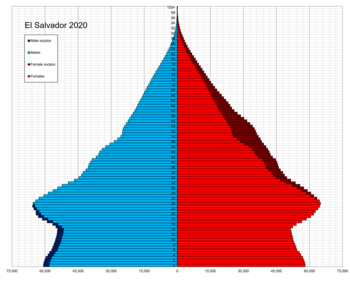This article possibly contains original research. (June 2021) |
| Demographics of El Salvador | |
|---|---|
 Population pyramid of El Salvador in 2020 | |
| Population | 6,568,745 (2022 est.) |
| Growth rate | 0.57% (2022 est.) |
| Birth rate | 17.87 births/1,000 population (2022 est.) |
| Death rate | 5.91 deaths/1,000 population (2022 est.) |
| Life expectancy | 75.37 years |
| • male | 71.88 years |
| • female | 79.04 years |
| Fertility rate | 2.05 children born/woman (2022 est.) |
| Infant mortality rate | 12.14 deaths/1,000 live births |
| Net migration rate | -6.29 migrant(s)/1,000 population (2022 est.) |
| Age structure | |
| 0–14 years | 25.48% |
| 15–64 years | 65.47% |
| 65 and over | 9.06% |
| Sex ratio | |
| Total | 0.92 male(s)/female (2022 est.) |
| At birth | 1.05 male(s)/female |
| Under 15 | 1.05 male(s)/female |
| 65 and over | 0.68 male(s)/female |
| Nationality | |
| Nationality | Salvadoran |
| Major ethnic | Mestizo (86.3%) |
| Language | |
| Official | Spanish |

This is a demography of the population of El Salvador including population density, ethnicity, education level, health of the populace, economic status, religious affiliations and other aspects of the population.
El Salvador's population numbers 6.03 million. Ethnically, 86.3% of Salvadorans are mixed (mixed Native Salvadoran and European (mostly Spanish) origin). Another 12.7% is of pure European descent, 1% are of pure indigenous descent, 0.16% are black and others are 0.64%.[1]
- ^
 This article incorporates text from this source, which is in the public domain: "The World Factbook — Central Intelligence Agency". Cia.gov. Retrieved 4 October 2017.
This article incorporates text from this source, which is in the public domain: "The World Factbook — Central Intelligence Agency". Cia.gov. Retrieved 4 October 2017.